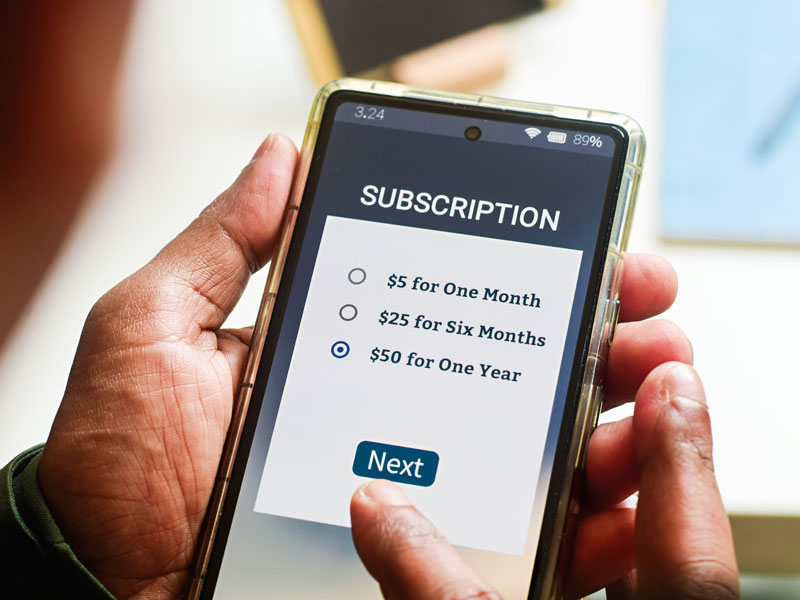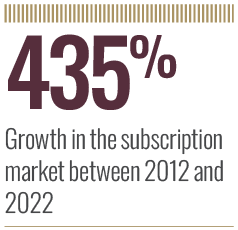
 
Author: Vikki Davies, Features Writer
For more than a decade, the subscription model has reigned supreme. From streaming giants like Netflix to SaaS start-ups and direct-to-consumer services, recurring revenue has become the holy grail for business models across sectors. Investors love the predictability, companies value the customer loyalty it fosters and consumers, at least initially, embraced the convenience.
Now it appears that subscription fatigue is setting in. The term coined to describe consumers’ growing reluctance to engage with an ever-expanding roster of recurring payments is fast becoming a concern for business leaders and investors. With consumers re-evaluating their digital wallets and churn rates on the rise, it is time to ask: Has the subscription economy peaked? Or is this merely a necessary recalibration in a maturing market?
From innovation to saturation
The success of the subscription model was once considered a sign of forward-thinking business acumen. The model delivered steady income streams, customer loyalty and higher lifetime value. It transformed product categories, turning everything from software and entertainment to pet food and razors into services. Between 2012 and 2022, the subscription economy grew by more than 435 percent, according to data from Zuora’s Subscription Economy Index. SaaS companies like Salesforce and Adobe became household names. Traditional businesses rushed to pivot. Even carmakers began experimenting with subscription-based access to vehicle features.
But as the model scaled, cracks began to show. What started as a convenience, a single-click, monthly bill for services we used regularly has become, for many, an overwhelming tangle of micro-payments. The average consumer today manages anywhere from six to 12 paid subscriptions, depending on geography and age group. The mental load is growing. And so is the frustration.
A fatigue-driven reversal
A recent academic paper published at the Proceedings of the third International Conference on Optimisation Techniques in the Field of Engineering (ICOFE–2024) takes a deep dive into the subscription phenomenon. Titled ‘Statistical Analysis of Subscription Fatigue: A Growing Consumer Phenomenon,’ the study by Sunori, Mittal and Gangola investigates the psychological and behavioural triggers behind subscription fatigue.
As more companies adopt subscriptions, the uniqueness of the model has eroded
The authors identify three key drivers: lack of perceived value, hidden or unpredictable fees and loss of control. As more companies adopt subscriptions, the uniqueness of the model has eroded. Many users now feel they are paying regularly for content or services that deliver little incremental benefit. Consumers also increasingly report frustration with tiered pricing, automatic renewals and freemium models that lead to unexpected charges.
Finally, the inability to manage or track multiple subscriptions easily contributes to a growing sense of overwhelm, leading to attrition. Combined, these factors erode loyalty and trust, two foundational elements of the subscription promise.
The numbers behind the trend
While full-scale collapse is unlikely, the subscription economy is clearly entering a more mature and arguably more volatile phase. A 2024 report from Antenna, a subscription market analytics firm, revealed that churn rates for video-on-demand services reached an all-time high of 44 percent in Q4 2024. SaaS businesses, too, are seeing rising customer acquisition costs and declining net revenue retention, a double hit that undercuts the long-term profitability of the model.
Consumer surveys tell a similar story. According to the UK’s Department for Business and Trade who have launched a consultation on measures to crack down on what they call ‘subscription traps,’ nearly 10 million of 155 million active subscriptions in the UK are unwanted, costing consumers £1.6bn a year.
Business Secretary Jonathan Reynolds said: “Our mission, which is tackling subscription traps that rip people’s earnings away, is an important part of that. Everyone hates seeing money leave their account for a subscription they thought they had cancelled, or a trial that unexpectedly gets extended. We are looking to hear from as many businesses, consumer groups and other interested groups as possible to allow us to set fair regulations that stop this corporate abuse of power while retaining the benefits of subscriptions for consumers and businesses.”
Deloitte’s 19th annual ‘Digital Media Trends’ report also found that consumers are increasingly dissatisfied with the value of paid streaming services. Even though 53 percent of consumers surveyed say that streaming video on demand services are the paid media and entertainment services they use most frequently, almost half (47 percent) say they pay too much for the streaming services they use, and 41 percent believe the content available on these services is not worth the price (up five percent from 2024). A price hike of $5 would be likely to make the majority (60 percent) of consumers cancel their favourite service.
And while the cost-of-living crisis in parts of Europe and North America certainly contributes, the deeper issue is structural: subscriptions are no longer novel, and consumers are becoming more discerning about where they spend their monthly budgets.
Winners and losers in the next phase
Importantly, not all subscription businesses are experiencing the same levels of fatigue. Some have weathered the storm better than others. The difference lies in how well the service aligns with customer value and how flexible the business is in responding to changing expectations. Services that are truly integral to daily life, such as productivity tools like Microsoft 365 and Dropbox, health and wellness platforms like Strava, or high-engagement entertainment like Spotify or Disney+ tend to maintain stronger retention. These companies have invested heavily in clear pricing and cancellation policies, personalised content or features and frequent, visible product updates. Crucially, they make it easy for customers to understand what they are paying for, and why it is worth it.
On the other end of the spectrum, many niche services or companies with minimal product differentiation are struggling. Despite having 45 million subscribers, Apple TV+, for example, reportedly incurs over $1bn in annual losses. The platform captures less than one percent of total US streaming viewership, lagging behind competitors like Netflix. High production costs and limited audience engagement contribute to this subscription model’s financial struggles.
Amazon Prime is also struggling. The introduction of additional advertisements in 2025 has led to subscriber dissatisfaction. Users now need to pay extra to avoid ads, prompting some to consider cancelling their subscriptions. Companies like Garmin and Polar have introduced subscription fees for features that were previously free, also leading to user backlash. Consumers have expressed frustration over paying for functionalities that were once included with device purchases.
The era of ‘everything-as-a-subscription’ from digital fitness classes to premium recipe apps is being ruthlessly culled by consumer pragmatism. Likewise, businesses that rely on passive engagement (the assumption that users will forget to cancel) are seeing that strategy backfire. With fintech tools and banking apps now offering subscription tracking and cancellation features, the days of accidental renewals are coming to an end.
Is this the end of recurring revenue?
Not quite. But it is the end of blind faith in the model. The golden era of subscriptions was driven by novelty and investor enthusiasm. But like all financial trends, the hype curve eventually levels off. What is left is a need for quality and sustainable economics.
Investors, once obsessed with monthly recurring revenue, are now scrutinising unit economics more closely. What is the actual cost to acquire and retain a subscriber? How long does it take to recoup that investment? And is the model still viable without aggressive discounting?
The subscription model is entering a new phase where survival depends on depth, not breadth
Subscription businesses are being pushed to evolve. In many cases, that means offering hybrid models that combine one-time purchases with added subscription perks and creating modular pricing tiers that better reflect real usage patterns. Rather than chasing pure subscriber volume, companies are increasingly focusing on metrics like net retention and user engagement. This evolution mirrors a broader shift in the digital economy, from a growth-at-all-costs mentality to a more responsible, resilient approach to long-term success.
A recent study by research agency 2CV highlights growing consumer frustration with subscription models and how to build trust and long-term loyalty, suggesting that providers must focus on clear and consistent communication.
As the report notes: “Subscription providers need to properly understand their subscribers, what are their expectations, their preferences, wants and needs? Really knowing your audience and aligning subscription plans to their preferences can help retain consumers, build loyalty and prevent them from cancelling in preference for more appealing offers elsewhere.”
For financial professionals and corporate strategists, the implications are significant. Key questions for subscription-based businesses today include whether their model genuinely reflects real consumer value or if it is simply propped up by customer inertia. They must also consider what safeguards are in place to protect against churn shocks, particularly during economic downturns. Agility in adjusting pricing and packaging is critical, as is ensuring that KPIs and dashboards measure the quality of retention, not just the number of subscribers.
It is also a moment to re-assess valuation models. Recurring revenue still offers stability, but the premium investors have placed on the model may need recalibrating. In short: it is no longer enough to have subscriptions; you must have subscribers who stay.
What comes next?
Much like the evolution of e-commerce or mobile apps, the subscription model is entering a new phase where survival depends on depth, not breadth. Companies will need to earn their recurring revenue every month, not assume it. The future of subscriptions lies in trust, transparency and tangible value. Those who listen to consumer signals and respond with clarity, flexibility and innovation will not only survive this phase, but thrive in it. And for the rest? The unsubscribe button has never been easier to find.